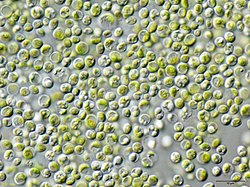Chlorella
Chlorella is a genus of single-cell green algae. It is in the division Chlorophyta. It is microscopic in size and round in shape.
Chlorella has in its body two green color substances: "chlorophyll-a" and "chlorophyll b." It uses photosynthesis, similar to plants which also have chlorophyll. It multiplies rapidly, needing only carbon dioxide, water, sunlight, and a small amount of minerals to reproduce.[1]
Many people believe Chlorella can serve as a possible source of food and energy. This is because its photosynthesis process can, in theory, reach 8% efficiency.[2]. This is even better than that of other highly efficient crops such as sugar cane, which are already being used for food and energy.
In 1961, Melvin Calvin of the University of California received the Nobel Prize in Chemistry for his research on the pathways of carbon dioxide assimilation using Chlorella.
References
- ↑ Scheffler, John (3 September 2007). "Underwater Habitats". Illumin. 9 (4).
- ↑ Zelitch, I. (1971). Photosynthesis, Photorespiration and Plant Productivity. Academic Press. p. 275.
